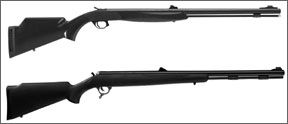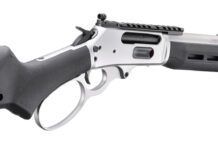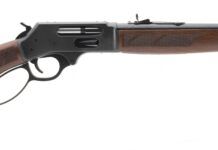Muzzleloading has enjoyed unprecedented growth over the last 20 years-unprecedented not just compared to its own prior popularity, but also compared to shooting sports in general. As of today, we have an estimated 3.5 to 4.5 million muzzleloading enthusiasts in the United States. Along the way, we have had offering of both good and bad equipment-some additions that have made the sport safer, more enjoyable, practical, and effective, and more than a few attempts that have not.

The current story has its roots back in 1985, when railroad man William Anthony “Tony” Knight named his first muzzleloading rifle the “MK-85” after his daughter Michelle, and sought to modernize the sport. It took more than a few years, not taking firm root until the mid-1990s, but the pull-cock or “Enfield type” action Mr. Knight employed proved reliable, and the Knight legacy began. Gary “Doc” White, M.D., took a close look at the older Sir James Whitworth rifle and made his own Enfield-style rifles revered by many to this day such as his “Super 91.” It is a good thing to see what you are shooting at, a very good thing indeed, and his modern treatments of ancient inline designs were more easily scoped, making the rifles both safer for everyone and more humane to use for those with less than perfect vision, meaning just about everyone. Thompson/Center, entering the firearms business with the production of Warren Centers Contender, finally decided that its sidelocks were no longer competitive with the Knight and White products, and released its copy of the Knight/White style of rifle as the T/C Black Diamond. From the mid-1990s until 2002, things stayed very much the same.
In 2000-2002, though, there were big changes. Master riflesmith Henry Balls patents found life in the superb Savage 10ML and 10ML-II rifles, a Thompson office-bet fling at producing muzzleloading barrels for the T/C Encore found surprising success, serving as impetus for the break-action craze, and in 2002 Thompson-Center surprised the muzzleloading world with its Omega, one of the most successful (and copied) muzzleloaders of the day.
Along the way, there have been a few unpleasant surprises, of course, most notably from foreign companies such as CVA and importers such as Traditions that have inflicted soft, extruded barreled, poorly produced frontloaders on the U.S. market. These attempts at soaking American muzzleloading enthusiasts out of dollars by riding piggy-back on the Knight/White/Thompson successes is a tragedy.
Safety is no optional quality for us. So in our search for effective yet affordable inline muzzleloader, we have turned to two reputable companies, Knight Rifles and Thompson/Center, that use certified and appropriate metals to produce their products. The compared economy muzzleloaders are the Thompson Omega Z5 .50 caliber in blued-composite (item # 8898) and the new for 2008 Knight Shadow .50 caliber, also in blued- composite (item # KS606C). Both rifles are targeted toward the entry-level or value-minded shooter, and both can be had currently for well under $350. We believe it is important to start with a muzzleloader of reasonable quality and performance. If muzzleloading is more hassle than fun from the start, many wont find much reason to continue with it. The same goes for most all shooting sports equipment.
Heres what our test team thought about both guns:
Thompson Omega Z5 8898 .50 Caliber, $310
With the sales of scope-burning pull-cock or plunger rifles quickly fading, Thompson staffers took a look at what they could do to stay competitive as their Black Diamond sales faded. The Omega Z5 is the result; it is essentially the regular Omega .50 caliber with a carbon-steel barrel and a plastic stock. We were immediately surprised, pleasantly so, at what we found in this value edition of the popular Omega.
The Omega Z5 came supplied with a one-piece Weaver style base already installed, a much appreciated touch. We installed a Bushnell Elite 3200 3-9x40mm scope with a pair of Warne steel medium-height quick-release rings with no hassle. Unlike some economy models that have the equivalent of Popeil Pocket Fisherman ramrods capable of landing a moderately sized bluegill but incapable of proper bullet seating, the Omega Z5 ramrod is made from sturdy aluminum. As well, the Omega features two metal ramrod ferrules to retain the ramrod, not the cheesy plastic we see on some economy models. The iron sights, while not as good as the original Omega and Encore versions, are still the popular and well-accepted Williams fiber-optic set, which worked well during our scopeless shooting.
We were also pleased with the Omegas deep, rich barrel blue. It was a big notch up from the various paint or crude “tool blackening attempts” found on other economy rifles, and far more attractive (and apparently more durable) than the black wash used on the Knight Shadow. We were also pleased, if not delighted, with the Omegas trigger that broke at a crisp and repeatable 4.1 lbs. It is a far better trigger than both the previously tested Knight KP-1 and the pricey Thompson Encore Pro-Hunter, and it really put the Knight Shadows trigger attempt to shame, our test team said.
The Omegas plastic stock was average, and the generic and almost properly fit recoil pad was also adequate. The stock appeared to us as the only noticeable concession compared to higher-priced models, but still was quite suitable and usable especially considering the price point of the model. It is remarkable only in the sense that the rest of the rifle is so good.
Scoped-up and ready to go, the Omega weighed in at just under 9 pounds. All of our shooting was with Western Industries Blackhorn 209 propellant. The Omega gave us better velocities with the same load than did the Knight Shadow. For example, the Barnes Spitfire T-EZ 250-grain sabots averaged 1857 fps with 100 grains of volumetrically measured Blackhorn 209; the Knight Shadow clocked consistently over 75 fps slower. We had no hangfires or ignition issues with the Omega, something that we cant say for the Knight. Moreover, the breech area showed only light mung, not the heavy primer spittle we found on the Knight Shadow. We also appreciated the smaller, somewhat recessed, hammer of the Omega that made it easy to cock with our gloved hands. We had a good chance to test that because our range work was done on most days at 28 degrees with 20- to 30-mph winds.
The test Omega, had the typical “tight Thompson bore” of about .501 inch land to land. Though not as unbearably tight as our previously tested T/C Triumph, it still needed a smaller outside diameter sabot. The Barnes T-EZ 250-grain and Barnes T-EZ 29- grain sabots have a loaded diameter of .505 inch, and suited the Omega perfectly, giving us the .004-inch interference fit we sought. Fortunately for this comparison, the Knight Shadow had a fairly tight bore (for a Knight) of about .5015 inch land to land, so we were able to use the same pair of projectiles in both rifles. We also used (or attempted to use) 295-grain “bore-size” Powerbelts in both rifles that sprayed attempts at groups over 3 to 4 inches at 75 yards, so though used the results were so poor in both rifles that they rendered accuracy comparisons with this projectile meaningless.
Despite cold and very windy range conditions, the Omega was able to keep its groups in the 1.25-inch range at 75 yards, clearly outshooting the Knight and outshining it in every way that mattered to us.
Knight Shadow KS606C .50 Caliber , $250
A quick check of the Knight offerings over the last several years shows that we can invariably count on Knight to both introduce more muzzleloading rifles and discontinue more muzzleloading rifles every year than other manufacturers combined. Followers of Knight might reasonably expect the clumsy Knight Vision to fade away, along with the overly proprietary .52-caliber offerings. Though Knight has had it share of stink bombs, some of its new offerings (the KP1 Utility Rifle, reviewed in GT) show great potential, even if that potential is not realized as of yet. There is a bit of irony in Knights Shadow, a break-action muzzleloader that Knight has long steered clear of.
It was the accidental success of the T/C Encore as a muzzleloader that inspired much of the notion that “break-action” is desirable in a muzzleloader. With the success of the Encore muzzleloader, it wasnt long until CVA and then Traditions tried to pass off their pot-metaled Encore look-alikes as being similar to the Encore. They are not, and never have been in the same league, of course. Knight has long resisted the urge to follow T/Cs lead, clinging to the idea of discs and full red plastic jackets that fewer people want to fuss with year after year. In any case, the Shadow is here.
Intended to compete at an entry-level price point, a few obvious compromises were made to get the cost out of the Shadow. The receiver is alloy, for example. Not a bad area to focus on, as a receiver on a muzzleloader doesnt attempt to do a great deal, not having to deal with cartridge or even shotshell thrust-the only thing blowing back is a primer. The omnipresent cheap, flimsy, plastic Knight ramrod is of course present on this rifle, and the synthetic stock (plastic the way we look at it) is adequate, even if the poorly fitted generic recoil pad shows a lack of assembly care. The cheap ramrod is held in place by a single cheap plastic ferule. The iron sights are the competent Williams fiber-optic units.
Pulling in on an alloy block-shaped button that protrudes from the front of the trigger guard unlocks the action. It isnt effortless, not nearly as easy to use as an Encore or Knight KP1, but it is functional. We used steel Weaver S45 bases and high Warne Maxima QR rings to mount a Burris Fullfield II 2-7x35mm scope. There is adequate hammer clearance, but just barely. Many folks would likely use the hammer spur even with high bases. It was a bit of a hassle to cock as is in our cold weather shooting, but still workable without the spurs. Bulkier gloves would necessitate hammer spur use. Scoped up as described, the Shadow weighs about 8.75 pounds-about a quarter-pound lighter than the as-tested Omega.
The Knight Shadows non-adjustable trigger was poor, suffering from a lengthy initial take-up and then a gritty pull before eventually breaking at about 6-3/4 pounds. It was a pain to fight at the bench, particularly when compared the Omegas far superior trigger effort. The Knight Shadow was noisy to cock, emitting an annoyingly loud click that was many times louder than the Omega. It was, and is, irritating at best. We dont think it is particularly suitable for the quiet hunting woods though at the range it hardly mattered.
Initially, we shot the Knight Shadow with Blackhorn 209 with no ignition issues. Our Burris Fullfield ran out of left windage adjustment during preliminary sight-in, something that was an unpleasant surprise and had never been an issue on other muzzleloaders. We like the Burris Fullfield II 2-7, and find that its 60 inches of internal adjustment is adequate for most all rifles-but not this Knight Shadow. It appears that the Shadow can be problematic in this department. Such was not the case on the Knight KP1 for example, where the same scope had no internal adjustment issues.
Despite properly fitting sabots, we had hangfires with the Knight in our cold weather shooting, despite using Federal 209A primers. The problem is the poor Knight breechplug design that sprays primer residue all over the outside of the breechplug and inside the action, enough to foul the bottom of our scope. The Knight breechplug is recessed into the barrel, recessed so far that the breechblock does not come close to supporting it. Rather than properly encapsulating the primer as the Omega does, the 209 primer is held in its sloppy breech plug pocket by a magnet. Upon ignition, due to the sloppy fit and lacking any piloting support from an extractor, or support from the back of the action, the 209 primer is free to propel itself backwards spewing its spittle everywhere. Everywhere except where it is all supposed to go, of course, which is through the breechplug to ignite the powder. Why apparently only Savage Arms and Thompson/Center can design an efficient breechplug is a mystery. Only in muzzleloading are consumers asked to tolerate this level of violent, unnecessary spewdom. We shouldnt have to.
The Knight Shadow shot adequately, but vertically strung its shots. Still, it managed to record 75-yard groups (under poor range conditions) inside 2 inches while fighting its nasty trigger and the intermittent hangfires.



























